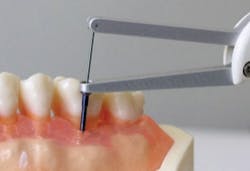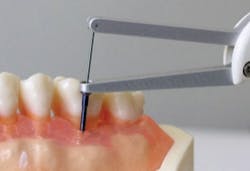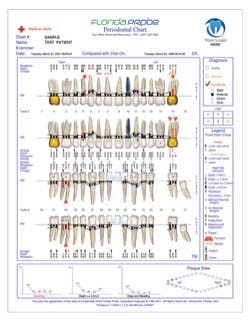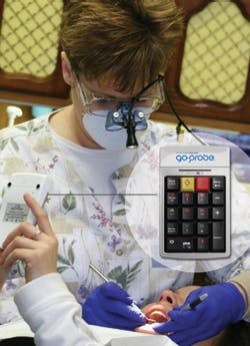Florida probing in Texas
When discussing the value of comprehensive periodontal evaluations with my audiences, I usually take a survey to determine how many clinicians are using or are familiar with constant-force probing. The numbers are consistently low in terms of those using this technology. For the last 15 years I have used the Florida Probe technology in private practice. Over those 15 years, many other technologies have transformed the practice of dental hygiene — digital X-rays, caries detection technology, salivary diagnostics, locally delivered antibiotics, oral cancer screening technology, visual magnification and illumination, laser treatment, intraoral technology, and the list goes on. What remains largely unchanged for most dental hygienists is the method of collecting periodontal data. I hope this column piques your interest to explore the world of Florida probing, regardless of where you are.
The issue of not having someone available to assist with data collection was what initially piqued my interest in Florida Probe. But what I have discovered is that this technology provides state-of-the-art diagnostic data that engages the patient and also ensures accuracy between clinicians. Florida Probe enables clinicians to collect probing measurements, document bleeding and suppuration, record recession, mobility, plaque accumulation, furcations, and even record minimal attached gingiva, all unassisted while the patient listens. The computer voice can be set to male or female voice, and it is available in 14 different languages.
Our office has five dental hygienists and two dentists, all of whom have different techniques, experience, and force when using a probe, just like all clinicians. The Florida Probe provides a constant force of 15 grams of pressure each time we take a measurement, irrespective of which clinician is using the technology. That type of calibration and reproducibility ensures the measurements are accurate. In fact, a 2003 study published in the Journal of Periodontology reported that examiners trained in the use of the constant-force probe were able to reproduce reliable results using the Florida Probe, and reproducibility was consistent with under 0.5 mm of error, even with 7 to 14 days between examinations.1
The probe is calibrated to measure within 0.2 mm of depth, so one can literally determine if a pocket measures 4.4 mm or 4.6 mm, rather than guessing if it should be recorded as a 4 or 5 mm pocket. The probe is automatically read when inserted into the pocket, as the probe sleeve touches the gingival margin as depicted in Figure 1. As the clinician depresses the foot pedal, the computer voice audibly records the measurement. Guesswork is eliminated, and both the clinician and patient are informed of the pocket depth. Additional data is easily documented using the probe and the foot pedal, and is audibly recorded in the chart.
The actual periodontal chart is proprietary to Florida Probe as shown in Figure 2, and normal measurements of 1 mm to 3 mm are recorded in black, 4 mm and greater in red, bleeding in red, suppuration in yellow, and comparisons between past charting are shown by green arrows for improvements and red arrows for deeper pocket depths.
It is easy for patients to readily discern what their chart reveals in terms of health versus disease. Charts can be emailed to specialists and/or physicians for consultation, and the Florida Probe software integrates easily to all major dental practice management systems. Clinicians can choose to complete comprehensive data collection, which typically takes 15 to 20 minutes depending on the extent of data being recorded, or pocket depth and bleeding only, which typically takes six or seven minutes to complete.
A unique feature of the Florida Probe system is the ability to document a periodontal risk assessment for a patient once data has been completed. It can merge periodontal data and systemic and medical information on the patient to assign a risk of low, moderate, or high for active disease, and is depicted in a colorful “spider graph” in which low risk factors are plotted in green, moderate risk factors in yellow, and risk factors ranking high for periodontal disease are in red as shown in Figure 3. One powerful aspect of the risk assessment chart is the ability to see the spider graph change following active therapy as a patient’s periodontal status improves and risk factors for future disease are reduced.
Even though the Florida Probe technology has been available for over 20 years, in recent years a second system called the GoProbe has been made available to clinicians. This system enables clinicians to collect data independently using the computer voice to audibly state the pocket depth as it is entered from a keypad, but clinicians use their own probes instead of the constant-force probe. The GoProbe system has a keypad that can be strapped to the wrist or around the thigh of the clinician to independently enter data as probing is completed. Or, if the clinician prefers he or she can show patients how to enter their own measurements onto the keypad as they collect the data as shown in Figure 4.
Over the past 15 years, Florida probing in Texas has ensured that complete periodontal data stays current on all of my patients, and it has certainly made it easy to identify disease and enroll patients into nonsurgical treatment. While this system is certainly not the only technology that enables clinicians to record data independently, it is the only constant-force system with 20 years of clinical and scientific data behind it. You can learn more at www.Floridaprobe.com, and perhaps you should investigate what Florida probing might do for you and your patients.
Karen Davis, RDH, BSDH, is the founder of Cutting Edge Concepts, an international continuing education company, and practices dental hygiene in Dallas, Texas. She is an independent consultant to the Philips Corp. and serves on the review board for Dentalantioxidants.com. She can be reached at [email protected].
References
1. Araujo MWB, Hovey KM, Benedek JR, et al. Reproducibility of probing depth measurements using a constant-force electronic probe: Analysis of inter-and intraexaminer variability. J Periodontol 2003;74:1736-1740.
Past RDH Issues



